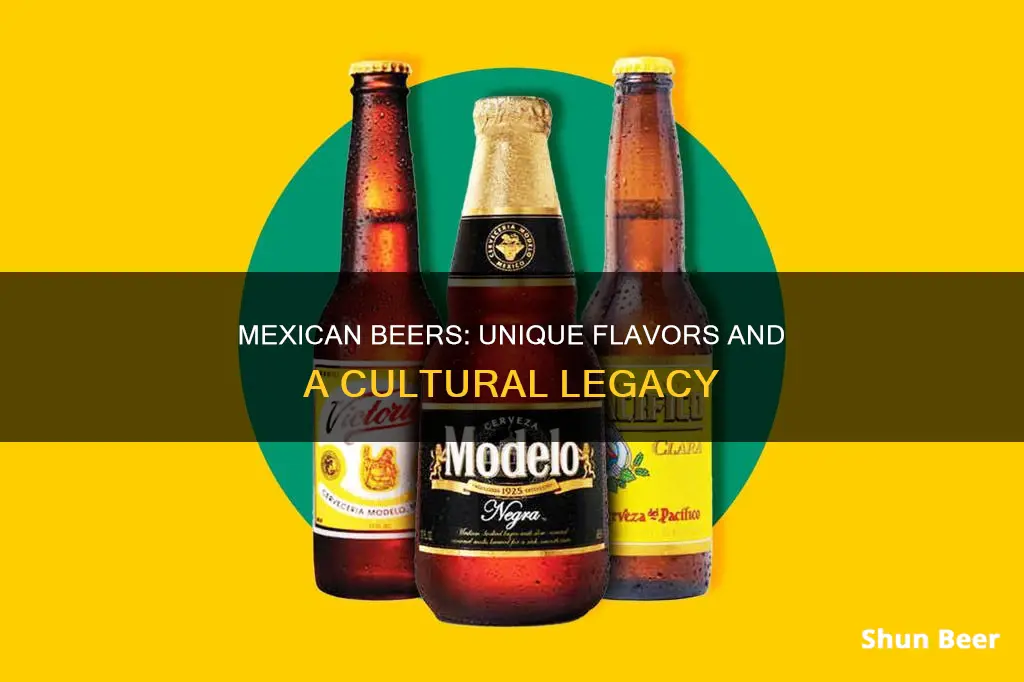
Mexican beers have become increasingly popular in the last few decades, with Corona Extra even making it into the top 5 best-selling beers in America. But what makes a beer Mexican?
The Mexican lager style is often characterised as a clean lager with low bitterness and high clarity, known as a Clara. However, the term can be controversial among beer enthusiasts as it can refer to many different beers. Generally, Mexican beers tend to be refreshing, with light flavours and low ABV.
The addition of corn or flaked maize to their beers is a key characteristic of Mexican beers, giving them a light golden colour and a crisp, refreshing finish. This is what sets them apart from American beers, which tend to be bolder and hoppier, with higher alcohol content.
| Characteristics | Values |
|---|---|
| Appearance | Light golden colour |
| Taste | Crisp, light, easy to drink, refreshing, not overly sweet |
| ABV | Generally low |
| Ingredients | Pilsner or Vienna malts, adjuncts like corn/flaked maize, hops, barley, yeast, lime, salt |
| Brewing Process | Lagering |
| Style | Pale lager, Vienna lager, Pilsner, Clara, Obscura, Munich dark beer |
| Examples | Corona, Modelo, Dos Equis, Sol, Tecate, Pacifico, Carta Blanca, Bohemia, Noche Buena |
What You'll Learn
- Mexican beers are often lagers with low bitterness and high clarity, known as 'Clara'
- Mexican beers are often associated with a wedge of lime
- Mexican beers are often adjunct style, with corn or flaked maize added
- Mexican beers are often perfect for hot summers and casual drinking
- Mexican beers are often enjoyed with Mexican cuisine

Mexican beers are often lagers with low bitterness and high clarity, known as 'Clara'
Mexican beers are often lagers with low bitterness and high clarity, known as Clara. This style of beer has a long history in Mexico, dating back to the 19th century when German and Austrian immigrants brought their lager recipes to the country. These immigrants and their descendants played a significant role in shaping the Mexican beer industry, with the first major brewery, Cerveceria Cuauhtemoc, being opened in 1890.
The term "Mexican lager" can be controversial among beer enthusiasts as it can refer to a wide range of beers. However, it generally describes a clean lager with low bitterness and high clarity, which is the Clara. The addition of corn or flaked maize to the brewing process is a distinct feature of Mexican beers, giving them a lighter colour and a crisp, refreshing finish. This is especially true for macro-brewed Mexican lagers, which are extremely popular in the United States and worldwide.
The opposite of Clara is Cerveza Obscura, which is used to describe the darker beers of Mexico. While Clara beers are similar to European Pilsners, they typically use adjuncts like flaked maize, which gives them a unique flavour profile. In some regions of Mexico, the term Clara can also refer to a Radler or shandy-style beer, where lemonade or soda is added to a Pilsner-style beer.
The other popular style of lager in Mexican beer production is the Vienna lager, an amber-coloured beer that originated in Austria. Mexican brewers tend to add their own twist to this style by using flaked corn or maize to lighten the body of the beer.
Today, Mexico is the world's largest beer exporter, selling more than $4 billion worth of beer annually. The country's beer industry is dominated by two major conglomerates, FEMSA (Heineken-owned) and Modelo (AB InBev-owned), which together own 90% of the brewing market. However, there is also a growing craft beer scene in Mexico, with microbreweries popping up across the country and offering a wider range of beer styles.
Exploring Diverse Beer Markets: A Global Perspective
You may want to see also

Mexican beers are often associated with a wedge of lime
There are several theories as to why lime is added to Mexican beer. One theory suggests that the acidity of the lime juice was used to combat germs, dating back to ancient Meso-American practices. Another theory claims that the lime was originally added to mask the "skunky" taste that could develop in Corona's clear bottles due to exposure to light. The lime's citrus flavour also helps to keep flies away, and it can be used to wipe away any rust stains on the rims of beer bottles.
While the exact origin of the lime-in-beer trend remains a mystery, it has become an integral part of the Mexican beer experience, adding a zingy citrus flavour to the drink. In Mexico, the addition of lime to beer is often seen in the form of a Chelada, a popular beer drink that mixes beer, lime juice, salt, and ice. Furthermore, the growing appreciation of Mexican culture and its associations with sunshine and bright colours has led to the adoption of Mexican style techniques and ingredients, including lime, in summer beer offerings around the world.
The practice of adding lime to Mexican beer has sparked some debate, particularly regarding the proper way to garnish a beer bottle. While some bartenders use plastic gloves or tongs to avoid bare-hand contact with the lime, others find these methods cumbersome and prefer to use their hands or other tools like a fork or cocktail straw.
Beer vs Lager: What's the Difference?
You may want to see also

Mexican beers are often adjunct style, with corn or flaked maize added
The maize is added in the form of flaked maize, which is corn with proteins, oils and other components removed. This is added to the mash during the brewing process. The maize slightly dries out the beer, creating a subtle crispness, and its low protein content boosts clarity.
The use of maize in Mexican beers is also somewhat controversial, as it is used to enhance crispness and decrease the cost of the malt bill. Many American brewers have tried to improve on this style by using other adjuncts or techniques to create the same drinking experience.
The addition of corn or maize to Mexican beers makes them lighter and easier to drink, creating a refreshing beer perfect for hot Mexican summers. This adjunct style is less common in American beers, where adjuncts are normally used as a cost-cutting exercise.
The use of maize in Mexican beers is also practical, as maize is not native to Mexico, and therefore needs to be imported at a higher price.
IPA Beer: Unique Effects and Experiences
You may want to see also

Mexican beers are often perfect for hot summers and casual drinking
The unique characteristics of Mexican beers can be traced back to the 19th century when German and Austrian immigrants settled in Texas and Mexico, bringing their lager recipes with them. Soon, Vienna lager brewed with locally farmed maize became the drink of choice for many.
Today, Mexican beers are known for their adjunct style, with corn or flaked maize added to create a lighter, more refreshing beverage. This makes them perfect for drinking in hot weather and for casual, easy drinking.
Mexican beers are typically low in bitterness and have a high level of clarity, making them clean and pale in appearance. They are also usually low in ABV, which further adds to their easy drinkability.
The addition of corn or maize not only makes Mexican beers lighter and easier to drink but also gives them their distinctive light golden colour. This sets them apart from American beers, which tend to be bolder and hoppier, with higher alcohol content.
Mexican beers are also closely associated with Mexican cuisine and are often enjoyed alongside traditional dishes such as tacos, enchiladas, and guacamole. This cultural association has contributed to their worldwide popularity.
Explore the Difference Between Ales and Lagers in Beer
You may want to see also

Mexican beers are often enjoyed with Mexican cuisine
When it comes to food and drink matching, pairing Mexican food with the right beer can elevate the dining experience. Mexican cuisine can be broken down into a few general flavour profiles, each calling for a different style of beer. For dishes with creamy condiments or sauces, such as cheese-loaded burritos and creamy enchiladas, bitter beers with bright, citrusy hops like American pale ales are a great choice. The bitterness of these beers cuts through the richness of the dish, creating a delightful contrast.
On the other hand, for dishes with rich-braised meats and deeply flavoured sauces, such as mole poblano, a beer with higher alcohol content, carbonation, and body is ideal. A Belgian dubbel, for example, can stand up to the mouth-coating fat of these dishes while adding pleasant flavours of pepper, caramel, and raisin.
For those who enjoy extra-spicy Mexican cuisine, it's best to avoid beers with high alcohol, carbonation, and bitterness levels as these can intensify the heat. Instead, opt for malty beers like less-hoppy American blonde ales or paler beers such as witbier and helles. These beers provide a refreshing relief from the spice without overwhelming the dish.
When it comes to fatty and crispy dishes like fajitas, tacos al pastor, or carnitas, a smoked beer or a dark or amber lager is the perfect match. The caramelized flavour of these beers pairs exceptionally well with the browned meats of these dishes.
Lastly, for bright and light dishes such as ceviche, a crisp and refreshing beer like Tecate, Corona, or Pacifico is the way to go. These beers won't dampen the brightness of the dish, but rather enhance its lively flavours.
Whether it's a crisp lager, a refreshing pale ale, or a bold Belgian dubbel, Mexican beers offer something for every palate and pair beautifully with the diverse and flavourful world of Mexican cuisine.
EBC Beer Shipping: State-by-State Availability and Restrictions
You may want to see also
Frequently asked questions
Mexican beers are mainly lagers, pilsners, Vienna-style light and dark beers, and Munich dark beers.
Mexican lagers are generally clean and pale, with high clarity and low bitterness. They are usually refreshing and light-flavoured, making them perfect for casual drinking in the sun.
Mexican lagers are often made with Pilsner or Vienna malts. They also tend to include corn or flaked maize, which makes them lighter and easier to drink.
Mexican beers are generally lighter, more refreshing, and less bitter than American beers. American beers tend to be bolder, more hoppy, and have a higher alcohol content.







